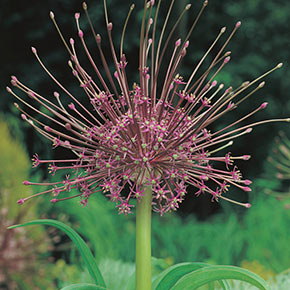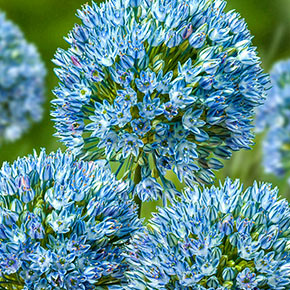
How to Plant, Grow and Care for Alliums
| Botanical Name |
Alliums |
| Plant Type |
Flower bulb |
| Sun Exposure |
Full sun to partial shade |
| Soil Type |
Well-drained clay, loamy or sandy soils |
| Soil pH |
Slightly acidic |
| Bloom Time |
Late spring to early summer |
| Flower Color |
Purple, blue, white, yellow, pink |
| Hardiness Zones |
4, 5, 6, 7, 8, 9 |
| Special Features |
Alliums attract pollinators, and deer and rabbits tend to avoid them. |
Alliums come in all shapes and sizes, and can fit into almost any garden design, from formal gardens, cottage gardens, prairie settings and modern chic. Like other flower bulbs, growing allium bulbs is easy. Alliums are members of the onion family, but these flowers are showier than garlic and onion varieties. They provide a bridge of color between spring-blooming daffodils and tulips and early summer flowers such as peonies. Learn how you can spruce up your landscape by planting alliums. Read ahead to learn more about when to plant allium bulbs, and more with our how-to guide!
Types of Alliums
Hundreds of allium varieties are available, ranging from low-growing, dainty alliums that grow under 12 inches tall to giant alliums that grow up to 6 feet tall. These popular alliums give you an idea of the variety in alliums available for home gardeners.

Globemaster: The dense, purple flowerheads grow up to 10 inches across, making a statement in the garden or a vase. Growing 32 inches tall, Globemaster is ideal for planting with lower growing perennials, other alliums or ornamental grasses. For an impressive effect, plant Globemaster in drifts. Blooms in early to midsummer.

Allium schubertii: Features some of the largest flowerheads—up to 14 inches across, with small, reddish-purple flowers. The unique and stylish flowers make it a favorite for cut-flower displays. Growing just 20 inches tall, it can be grown in a container. Plant this allium near a walkway where garden visitors can marvel at the flowerheads. Blooms in late spring to early summer.

Allium ceasium Zamin: Offers a less common flower color in alliums. The pale sky-blue florets have darker mid-veins, creating a refreshing look in the early summer garden. The 4-inch flowerheads sit atop 20-inch stems. For an impressive effect, plant these allium bulbs in drifts. They're also impressive planted in mixed perennial beds.

Allium Mount Everest: 4-inch, white flowerheads sit atop stems that grow over 4 ft. tall. Unlike other alliums, this variety keeps its foliage during bloom time. Mount Everest blooms in late spring and can be paired with purple-flowered alliums, ornamental grasses and other perennials. Its color and size make it a favorite for cut-floral displays, too.
When to Plant Allium Bulbs
Like other spring-flowering bulbs, allium bulbs are planted in the fall when the weather cools. When to plant allium bulbs often depends on where you live. In northern areas of the country, this is usually in September to October. In southern areas, it's usually in October to November. The best time to order your allium bulbs is late summer to early fall. Because alliums continue to grow in popularity, many allium varieties sell out quickly. When do alliums bloom? Depending on the variety, alliums bloom in late spring, early summer or midsummer.
Where to Plant Alliums
Most alliums grow in hardiness zones 4-9, making them suitable for many parts of the United States. You can find more information on growing zones at our zone finder page.
Alliums are sun lovers and perform best when planted in areas that receive six or more hours of direct sunlight daily. While they will grow in partial shade, they perform best in full sun. Like other flower bulbs, alliums grow best in well-drained soil.
Alliums are often planted with other sun-loving perennials and ornamental grasses. Lower-growing perennials and grasses can hide their foliage as it fades in the summertime. Some popular companion plants for allium include nepeta, iris, geraniums, salvia, sweet alyssum, bachelor's buttons, coreopsis and ornamental grasses.

How to Plant Alliums
Keep your allium bulbs in good condition by planting them soon after they are delivered. If you cannot plant them right away, open the cartons. If the bulbs are in plastic bags, remove them from the plastic. Place them on a tray in a cool, dark, dry, well-ventilated area until you can plant them. Do not store them at temperatures below 39 degrees F.
How deep to plant allium bulbs
Depending on the variety, allium bulbs are planted 3-6 inches deep and 6-12 inches apart. A good rule of thumb is to plant allium bulbs at a depth that is three times the size of the bulb. All allium bulbs should be planted in well-drained soil, rich in organic matter. The pointy side should be facing up. After planting, water them thoroughly.
Materials You'll Need
While a shovel or trowel is great for digging, an auger and drill can make allium bulb planting a lot easier. Both the Improved Bulb Auger and KneeSaver Planting Tool are time savers. Using an all-natural, slow-release fertilizer, like Van Bourgondien 100% Natural Bulb Food, at planting time can also give your alliums a boost.
How to Grow Alliums
Alliums are low maintenance and require little care. Follow these tips for successfully growing allium bulbs.
A light mulch can suppress weeds and retain moisture in the soil.
Most alliums don't require staking.
When the flowers bloom, the flowerheads can be left on the plant for months of interest or cut.
Allow the foliage to fade naturally. It's making nutrition for next year's flowers.
Learn more about alliums in our comprehensive garden guide.
Allium FAQs
What pests and diseases bother alliums?
Alliums are seldom bothered by disease. Allium white rot can be a problem. To prevent diseases, plant bulbs in well-drained soils and do not allow them to sit in soggy soils. Deer, mice and other animals don't care for the taste of allium and usually leave them alone.
What are harvesting tips for alliums?
Alliums make impressive cut flowers. Cut the stems when the flowers are starting to open.
What to do with alliums after flowering?
The flowerheads can be cut—or you can leave the flowerheads on the stems. The dried flowerheads add interest to the garden. Some people even spray-paint the dried flowerheads. Allow the foliage to fade naturally.
What do alliums represent?
Alliums symbolize prosperity and abundance, making them a great flower to give to others.
Why are alliums prohibited in Washington state?
Alliums are members of the onion family. Many state quarantine laws are in place to protect agricultural industries and often impact home gardeners.
Have another question? Return to the Customer Service Help page or send an e-mail directly to Customer Service











